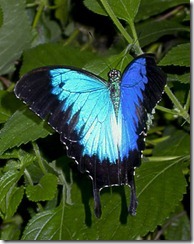Engineers have been trying to create water repellent surfaces, but past attempts at artificial air traps tended to lose their contents over time due to external perturbations. Now an international team of researchers from Sweden, the United States, and Korea has taken advantage of what might normally be considered defects in the nanomanufacturing process to create a multilayered silicon structure that traps air and holds it for longer than one year.

Researchers mimicked the many-layered nanostructure of blue mountain swallowtail (Papilio ulysses) wings to make a silicon wafer that traps both air and light. The brilliant blue wings of this butterfly easily shed water because of the way ultra-tiny structures in the wings trap air and create a cushion between water and wing.

The researchers used an etching process to carve out micro-scale pores and sculpt tiny cones from the silicon. The team found that features of the resulting structure that might usually be considered defects, such as undercuts beneath the etching mask and scalloped surfaces, actually improved the water repellent properties of the silicon by creating a multilayered hierarchy of air traps. The intricate structure of pores, cones, bumps, and grooves also succeeded in trapping light, almost perfectly absorbing wavelengths just above the visible range.
No comments:
Post a Comment